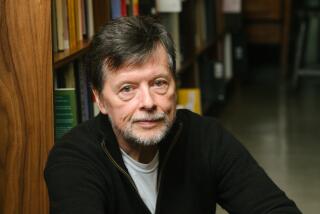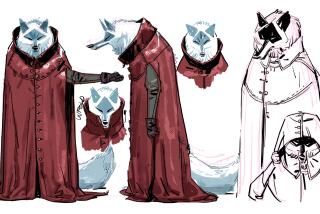An epic comeback
- Share via
It began as a pagan poem told around shadowy campfires about a hero fighting the monster Grendel, the monster’s mother and a dragon. Christendom’s world of saints and sinners reinvented Beowulf as a soldier of God and branded Grendel one of Cain’s evil kin.
“Lord of the Rings” author and Old English scholar J.R.R. Tolkien reintroduced the story to the modern world in 1936 as an important work of literary art rather than an obscure artifact of Old English language. Since then, it’s been resurrected in graphic novels, comic books, films and stage performances, including an opera and a dance theater production called “My Beowulf.”
There have been multiple translations, including a lyrical one by Seamus Heaney, which was a surprising bestseller in 2000. Earlier this year a dance company took over a Van Nuys skating rink to mount “Beowulf on Ice!” in which Grendel rode in on a big blue Zamboni ice-leveling machine.
Every age, it seems, has its own private Beowulf, a retelling of the 8th century Anglo-Saxon classic in the context of its tastes and preoccupations. In November, “Beowulf” returns in at least the second movie version to hit U.S. theaters in two years, a $150-million digitally enhanced live-action film adapted for Imax 3-D directed by Robert Zemeckis (“Back to the Future,” “Forrest Gump”) and starring Ray Winstone as Beowulf, Crispin Glover as Grendel and Angelina Jolie as Grendel’s mother.
So why “Beowulf”? And why now? After all, the poem is dreaded required reading for many undergraduates. In the movie “Annie Hall,” after Diane Keaton expresses an interest in enrolling in college classes, Woody Allen advises, “Just don’t take any course where you have to read ‘Beowulf.’ ”
But scholars, authors and fans say the poem endures because it is a timeless yarn about brave souls purging peaceful societies of agents of evil. Beyond that, the story’s built-in ambiguities and rough edges have always invited meddling.
Indeed, John Gardner’s 1971 novel “Grendel” told the story from the monster’s point of view. Gardner’s book inspired the opera “Grendel: Transcendence of the Great Big Bad,” which received its world premiere by L.A. Opera in 2006. Composed by Elliot Goldenthal and directed by his companion (and “The Lion King” director) Julie Taymor, it featured a sympathetic, though often grouchy, man-eating Grendel sung by a baritone. Beowulf never even sang, played instead by a dancer in what looked like a Speedo.
“It’s got a great core heroic story,” said Karl Hagen, language consultant for the new film. “but it’s also got enough ambiguity and difficulty to push people to reinterpret it and make sense of it for themselves. The idea has always been to try to make a unified story out of Beowulf by setting new ground rules for retelling it.”
New ground rules are necessary because so many words in Old English are open to interpretation. For example, the word used to describe Grendel’s mother, Ides, has traditionally been rendered as “something along the lines of a monstrous hag,” Hagen said. But in recent years, some scholars have suggested it means “valiant lady.”
Elsewhere in the poem, she is called Aglaecwif, which has been traditionally translated as “monstrous woman.” “But some scholars,” Hagen said, “believe it actually means ‘fighting woman.’ ”
Given the track record of some of the poem’s past distortions, the film, sight unseen, has triggered “Beowulf anxiety disorder” among textual loyalists who are wondering, “What are they going to do with ‘Beowulf’ now?” Some others, however, are intrigued over the prospects of the latest interpretation of the foundation of Old English literature.
“It seems we just can’t let go of ‘Beowulf,’ or it won’t let go of us,” said Robert Ellwood, professor emeritus of religion at USC. “Every time a classic is adapted, some scholars claim it’s their providence and others shouldn’t mess with it. Some others, however, argue that the more up-to-date a myth is the better.”
Ellwood added, “I tend to agree with [Claude] Levi-Strauss, who said, ‘A myth is all of its variants across time and space.’ In other words, a myth is for right now; it’s a living thing that adapts to different social situations.”
First written down around the year 1000, “Beowulf” opens by recounting the travails of Hrothgar, King of the Danes, who is under attack by Grendel. To the rescue arrives a young warrior.
“Beowulf is my name,” he brags. “I am ready and willing to report my errand.” Or, as he put it in Old English, “Beowulf is min nama. . . . paet we hine swa godne gretan moton.”
Beowulf slays Grendel. All is well, until Grendel’s mother shows up seeking revenge. Beowulf follows her to the bottom of a lake and kills her too.
The poem then abruptly advances 50 years to a time when Beowulf is a king and preparing to fight a dragon, guardian of a treasure. The dragon is slain, but Beowulf is fatally wounded and dies longing for the treasure.
Ellwood aims to be at the head of the ticket line when the Beowulf film hits theaters on Friday, and he’ll be taking notes. He plans to include the film in a series of public lectures he’ll be giving on myth and cinema at the Philosophical Research Society in Los Angeles every third Sunday, starting Sunday, through June 15.
Not that this is the first film version. There was recently “Beowulf & Grendel,” a Canadian art film shot in Iceland.
Because of the power of cinema the myths told in “The Wizard of Oz,” “Star Wars” and “Lord of the Rings,” Ellwood said, “are more alive and personally interesting to most present-day students than ancient examples. They are also more likely to work their way into one’s deepest levels of consciousness, resurfacing when needed to provide character models, and a worldview undergirding one’s own life journey.”
Some scholars are less than thrilled by the idea of the new 3-D film version of Beowulf. “I have colleagues who think the new ‘Beowulf’ movie is a travesty and disgusting,” said David Johnson, executive director of the International Society of Anglo-Saxonists and chairman of the department of interdisciplinary humanities at Florida State University. “Personally, I think anything that raises general public awareness of this material is fantastic.”
Academic debate was not the aim of the film’s screenwriters, Roger Avary and Neil Gaiman. Their goal was to use the latest cinematic technology to flesh out the ancient story for a 21st century audience, and to share what it was in the poem that caught them as high school students and never let them go.
“When Neil and I first sat down 10 years ago to forge this script based on notes I’d kept since high school, we saw ourselves as the latest in a very long line of shapers of the story,” Avary recalled. “ ‘Beowulf’ began as a pagan story, one told and retold for hundreds of years before it was put down on paper. Later, Christian monks added elements of Christianity for their audience.
“We’ve created a story structure a moviegoing audience can relate to,” he added. “After all, we go to the movies -- not to the campfire -- and this film is as large and spectacular as possible.”
A more visceral and dynamic version suits mythology scholar Ellwood just fine. “If the movie shows a way to be heroic and still accept the fact there are limitations to life -- that things will get better, and worse too, that’s a mythic message that might resonate.”
“But I can’t help but wonder,” he added. “How much did they change the ending?”
More to Read
Only good movies
Get the Indie Focus newsletter, Mark Olsen's weekly guide to the world of cinema.
You may occasionally receive promotional content from the Los Angeles Times.







